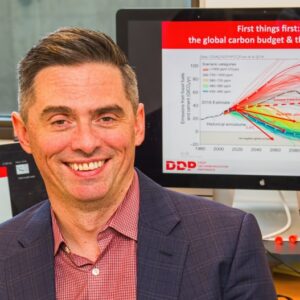Green industrial policy will drive decarbonization, but at what cost to trade?
The resurgent popularity of green industrial policy is a double-edged sword. On one hand, the protectionist provisions in the Inflation Reduction Act (IRA) were critical to the passage of the most significant US investment in climate action ever. Without the IRA’s domestic sourcing and final assembly requirements, President Joe Biden’s pledge of reducing US emissions 50–52 percent by 2030 would be out of reach. On the other hand, the same protectionist provisions have deeply frustrated US trade partners and aggressively bend—if not altogether break—international trade rules under the World Trade Organization (WTO) regarding equal treatment of foreign and domestic suppliers.
The Biden administration is working toward assuaging concerns over the IRA, which caught close US allies by surprise. However, this friction may be only the opening salvo in a decade marked by green trade tensions. It would be naive to think that the intersection of trade and climate policies will lessen—and not accelerate—with time.
The world should embrace the IRA and other green industrial policies, which are substantial, durable actions to meet climate commitments under the Paris Agreement. Still, they come with risk. For their part, the United States and others should establish guardrails to preserve the international trade rules that have underpinned global prosperity since World War II.
Domestic politics, international rules
The US brand of climate action laced with industrial policy is not a one-off. The political incentives that shaped the IRA are not unique to the United States. For many more countries, crafting ambitious climate policy that doesn’t erode key domestic support requires a mix of subsidies, tariffs, and regulations that current trade rules would heavily discourage if not outright disallow. The IRA’s expected pull on global clean energy investment is already encouraging others to follow suit.
For example, the European response—the Green Deal Industrial Plan and the Net-Zero Industry Act (NZIA), the legislation designed to realize the plan—bear a remarkable similarity to the IRA. The NZIA would further loosen state aid rules, the EU regulations regarding allowable domestic subsidies, to cover more types of clean energy projects. The European Union previously relaxed state aid rules at the start of the COVID-19 pandemic and again after Russia invaded Ukraine. The Green Deal Industrial Plan will also feature various funding measures and prioritizes workforce training to prepare European workers for maximum employability in the energy transition.
Importantly, Europe will also provide its own subsidies for domestic manufacturing in the form of a proposed European Sovereignty Fund, which would finance industrial policy initiatives, and an Innovation Fund to finance innovative demonstration projects. The plan emphasizes ambitious domestic manufacturing targets for a broad swath of clean energy technologies, including wind turbines, solar photovoltaic panels, heat pumps, batteries, and electrolyzers.
The European plan reflects reasonable worries among EU countries that their domestic firms will relocate to the North American market to chase the IRA’s generous subsidies. These worries coincide with high energy prices—driven, in part, by Russia’s war in Ukraine—that threaten to shrink major European industrial firms, such as German chemicals giant BASF SE and steelmaker ArcelorMittal. The IRA’s massive pull toward the US market will mean billions in new clean energy investment but could also redirect billions away from the clean manufacturing agenda in Europe and elsewhere, including in emerging markets.
At the same time, a fight over carbon tariffs is looming on the horizon. In December of last year, the EU finalized its carbon border adjustment tariff mechanism (CBAM), which extends the EU carbon price to imported greenhouse-gas-intensive products. As proposed, it will eventually impose tariffs on a broad swath of countries that do not have a domestic carbon price, including the United States and most developing economies. The EU’s CBAM, although designed to comply with existing international trade rules, has already provoked negative responses among policymakers around the world. US proposals to impose tariffs on the carbon embedded in imports, including the Biden administration’s Global Arrangement on Sustainable Steel and Aluminum (GASSA), are sure to elicit fury from the developing world as well, given the lack of comparable fees on domestic producers in the United States. These countries’ call for increased climate financing, including for loss and damage as a result of climate change—which gained momentum at COP27—only further compounds the ire. Developing economies, unable to compete with subsidy packages of their own, may instead limit imports of clean energy technologies and impose export controls on raw materials, and especially on critical minerals, for the political and economic leverage they provide, in an effort to move up the value chain.
The controversies over green subsidies and carbon tariffs could portend even more intractable conflicts at the intersection of climate, trade, and industrial policy throughout the decade. IMF chief Kristalina Georgieva has already cautioned against this trend, urging that green subsidies “be carefully designed to avoid wasteful spending or trade tensions, and to make sure that technology is shared with the developing world.”
If the momentum toward protectionism continues, the United States, the European Union, and others could drift into walled markets in which low-cost clean technologies cannot easily diffuse across borders, making it harder to decarbonize globally. This will be exacerbated by the limited capacity for emerging market economies to compete in a subsidy arms race. A worst-case scenario might involve a deluge of tit-for-tat cases at the WTO and retaliatory tariffs that fragment the global clean technologies market and decelerate climate action.
Forging green industrial coordination
Achieving a better outcome—in which such policies as the US IRA and GASSA and the EU NZIA, Emissions Trading Scheme, and CBAM accelerate clean investment across markets without encouraging fragmented trade—will depend on how US and EU trade partners shape their responses and how the United States and the European Union respond to partners’ concerns. Coordinated investment with heightened supply chain cooperation could instead create a supportive environment with partners and allies to spur climate progress. Negotiating comprehensive rules of the road for climate-focused industrial policy will be necessary to avoid a vicious cycle of protectionist measures that raise the collective cost or slow the pace of decarbonization. Conflict still looms, but early signs are promising, with US, Japanese, and EU leaders seeking compromise and the US Treasury interpreting IRA supply chain rules liberally so far. Biden and European Commission President Ursula von der Leyen reaffirmed their commitment to tackling concerns about both the IRA and the CBAM when they met in Washington in March.
The Biden administration, sympathetic to partners’ concerns about domestic sourcing requirements, has attempted to flexibly implement certain parts of the IRA, stretching the definition of “free trade agreement” to include critical mineral agreements with Japan and likely with the European Union soon. Still, local content requirements are only one among several controversial elements. Moreover, forging one-off critical mineral deals is no substitute for comprehensive coordination on climate and trade—especially if only the loudest and wealthiest countries receive concessions.
Revamping institutions like the WTO and a more immediate agreement in the form of a climate club, perhaps starting with steel, are necessary. In its current state, the WTO is woefully ill-equipped to balance the benefits of national climate-focused industrial policies against their negative consequences on trade relationships.
First, WTO stakeholders must find ways to update the organization to fit the times, lest major countries ignore it completely. That is, international trade rules must create room for carbon tariffs, limited green sourcing provisions, and similar policy agendas. Without these policies, the United States and the European Union may not meet their goals. Specifically, the WTO could align rules for domestic supply sourcing with a clear environmental component based on Article XX on General Exceptions—which outlines circumstances that may exempt WTO members from international trade rules—and recharge efforts toward a comprehensive environmental goods agreement that lowers trade barriers for clean energy technologies. The environmental clauses in Article XX, agreed to almost 30 years ago in 1994, are vague and far removed from the current urgency of the global climate crisis. The WTO could recognize that spending programs in support of emerging, innovative technologies are a legitimate part of the policy toolkit. These technologies might not commercialize without government subsidies, and governments likely cannot afford to make such large and risky investments without favoring homegrown firms and domestic jobs.
To be sure, subsidies paired with domestic content requirements might raise decarbonization costs compared with a hypothetical cost-effective pathway with unfettered free trade, but that approach has caused political backlash throughout the world and has discouraged—rather than spurred—government action on climate. Prompting speedy government action, a necessity given the dwindling carbon budget, may require sacrificing some economic efficiency.
Second, the Group of Seven (G7), which agreed to establish a climate club under the German presidency last year, should provide a forum for an agreement to form climate clubs to support deep decarbonization in emissions-intensive heavy industry sectors. These sectors’ products (for example. steel) are sold in homogenous markets with no differentiation for greener versions, are heavily exposed to international trade, and their facilities and workforces are often based in regions that are struggling. Domestic subsidies that incentivize commercialization and create stepping-stone markets for identifiably cleaner versions will be nearly impossible to avoid. Still, this effort must also direct concessional financing and technology assistance toward developing economies given that they will drive emissions growth in coming decades, especially in the aforementioned industrial sectors. Partnering with developing economies, especially those with inexpensive renewables potential and critical minerals, to help them develop global supply chains at the outset can boost them up the value chain in the manufacturing of clean energy technologies. This will prevent future supply chain dependence on a single country or region. Italy, which next holds the G7 presidency, and other key G7 members should begin work now to develop a provisional working agreement on trade in emissions-intensive goods that meets all the parties’ needs—ideally with active participation from developing economies.
Emerging green industrial policies are a starting point. The decisions policymakers make today will determine their ultimate trajectory. For example, whether the IRA achieves its full potential hinges on several inflection points, which include alleviating constraints on transmission, labor, and upstream commodity inputs. Similarly, its global impact and that of the EU’s NZIA, Emissions Trading System, and CBAM and of other future policies will be shaped by international responses. Economic competition and national self-interest are powerful drivers of climate action, but wielding that influence requires restraint and a minimum level of cooperation. Navigating this tension today will determine whether the cycle is a virtuous race to the top or a vicious spiral to the bottom.
Podcast

The passage of the Inflation Reduction Act in the United States unleashed its largest investment in climate and energy ever. But it also left many countries questioning some of its protectionist provisions, accusing the US of bending, if not breaking international trade rules under the WTO. So how do we move forward on climate without going backward on trade?
Opinions expressed in articles and other materials are those of the authors; they do not necessarily reflect IMF policy.











